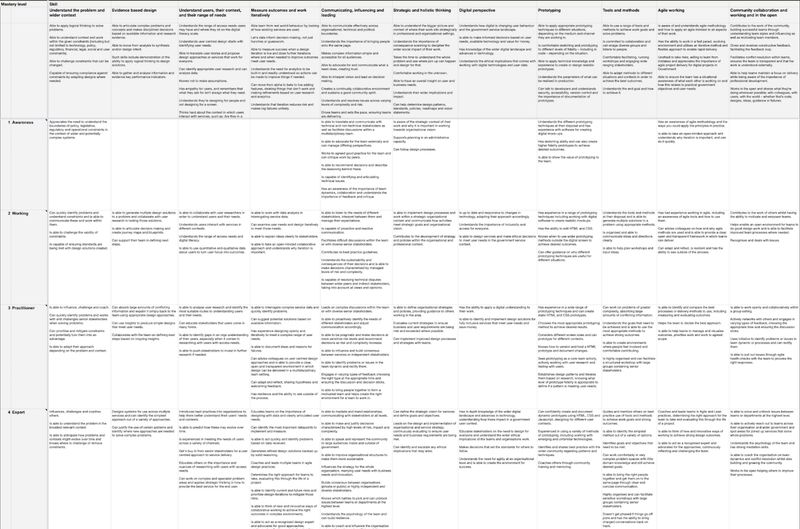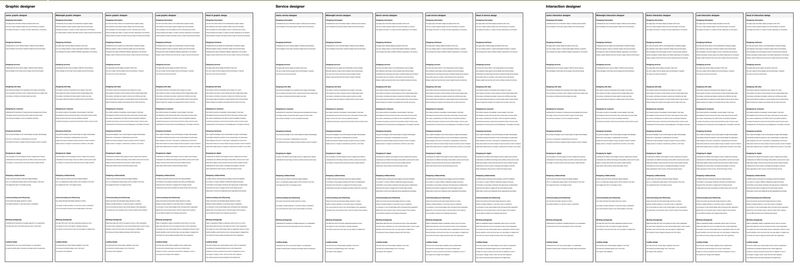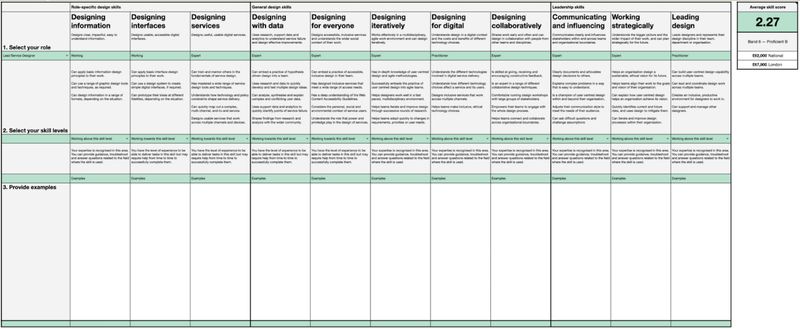Helping designers develop their careers

The challenge #
When designers join the government they need equal access to opportunities for career progression, regardless of who they are or which department they are in.
The Government Digital Service (GDS) publishes capability frameworks for Digital, Data and Technology (DDaT) roles in government.
Capability frameworks specify the skills and experience required by practitioners of a discipline at different levels of seniority.
They are used by departments to create a consistent and fair approach to things like recruitment, performance management and pay.
The capability framework for design roles in government was originally co-created by Heads of Design from different departments.
By 2020 it had not been updated in a few years, and it was starting to be used for activities that it had not originally been intended for.
One of these new activities was skills assessments, which were being piloted in GDS with the intention of them then being adopted more widely.
Skills assessments allow DDaT practitioners in government to receive an additional allowance on top of their base salary, based on their overall capability.
They’re a way for practitioners to progress their careers without having to apply for a new job.
My role #
As Head of Interaction Design for GDS, I set myself the challenge of reviewing the framework in advance of the pilot, to check whether it needed any adjustments.
I conducted research, redesigned and rewrote the framework, and developed new assessment tools for it.
During the 2 month project I engaged regularly with other government Heads of Design, to validate and get buy in for the work.
Method #
First I reviewed the current framework and interviewed designers from different departments about their experience with it.

I found:
- inconsistent terminology
- varying amounts of detail
- duplication across skill descriptions
- bias towards some roles or levels
- skill descriptions which would be hard to evidence
- a lot of academic and technical jargon
- roles and levels that were hard to compare
- skills that had no descriptions at some levels
Based on these findings I developed a set of principles that would inform the rest of the project:
- Fairness: All three role types should offer equal opportunities for career progression
- Clarity: Any designer should be able to see what they need to do to progress to another level
- Consistency: The same concepts should be described in the same terms throughout the framework
- Predictability: Each skill description should build on the previous one in a predictable way
- Exclusivity: There should be minimal overlap between the statements across different skills
- Demonstrability: It should be clear to a designer how they can demonstrate that they meet a statement
I then began to iterate the framework - removing duplication and jargon, filling gaps, applying consistent language and a predictable structure.
I ran research sessions with designers and Heads of Design from different departments, and used their feedback to iterate the work further.
Here’s the finished result:

All the images on this page are of this Google Sheet.
To accompany the framework I also created a skills matrix that shows the level of each skill required for the 3 design disciplines and 5 seniority levels.

Using the matrix I was able to ensure that progression opportunities were evenly distributed across the whole framework, making it more equitable for designers.
By combining the framework and matrix I was able to automatically generate the skill descriptions for all 15 design roles.

I worked with the HR team in GDS to understand how the Cabinet Office planned to map skills assessment outcomes to capability levels and pay allowances.
This enabled me to build a tool that designers could use to see exactly what their allowance would be for a certain combination of skills.

Outcome #
The revised framework and tool was successfully used in the skills assessment pilot in GDS, and Heads of Design in other departments have expressed an interest in using it.
The DDaT team in GDS also took an interest, and plans to use the same principles and methodology for other disciplines.
Designers reported that they found the new framework easier to use, and that it helped them to identify skills gaps and development opportunities.
"The updated format of the roles is approachable and I find it easy to see where I 'fit', and the skills that I'm perhaps missing or need to develop." - Designer, GDS
We're now using the new framework in GDS to rewrite our job descriptions, sift criteria and interview tasks and questions.
Thanks to... #
Thanks to Stephen McCarthy and the other Heads of Design in government, for feedback and encouragement throughout.
Also thanks to the DDaT and People teams in GDS, for their patience in explaining how HR in government works.